Rarepepe: How pepes were made provably rare on the bitcoin blockchain, and what it has meant for NFT culture and technology
Rarepepe is often credited as being the NFT project that gave birth to cryptoart. The history of Pepe the Frog and the Rarepepe project encapsulates themes and subject matter important to the development and history of the 21st century, especially regarding internet culture and its intersection with politics, society, technology, and art. As such, Rarepepe acts as a prism through which we can understand much of who we are and how we got here over the past 2 decades. It’s a closeup snapshot and portrait of what will be remembered as a critical turning point for mankind. It is singular as a project within the NFT space. Not only is it one of the first NFT projects ever, it has several other unique attributes. It was minted on the Bitcoin blockchain using the Counterparty protocol, which was an important innovation in and of itself. The art is entirely user generated from the Rarepepe community over the course of two years (2016-2018). It has 1774 unique cards, each with their own issuance making the entire number of available assets quite large. It contains many ‘firsts’ in the NFT space: first music embedded in an NFT; first NFT bonus content; first NFT used as a currency; some of the first GIFs minted as NFTs. 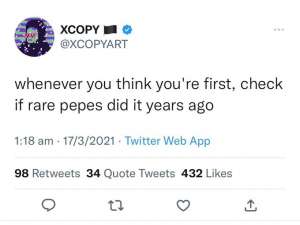 Rarepepe was the first NFT project to riff on various cultural subject matters, including politics, sports, cartoons, fine art, movies, the economy, and of course, cryptocurrency. As the famous crypto artist known for his glitch style XCOPY once tweeted, “whenever you think you’re first, check if rare pepes did it years ago” 3/17/21. The project’s provenance is rich and timeless, which makes it the most interesting things going on in the NFT space. I hope you enjoy learning about the history and provenance of this remarkable movement in blockchain art.
Rarepepe was the first NFT project to riff on various cultural subject matters, including politics, sports, cartoons, fine art, movies, the economy, and of course, cryptocurrency. As the famous crypto artist known for his glitch style XCOPY once tweeted, “whenever you think you’re first, check if rare pepes did it years ago” 3/17/21. The project’s provenance is rich and timeless, which makes it the most interesting things going on in the NFT space. I hope you enjoy learning about the history and provenance of this remarkable movement in blockchain art.
The History of Pepe the Frog
It all started in 2005 with the creation of the Boy’s Club comic by artist Matt Furie. Boy’s Club is a series of four comic books that “showcase slacker roommates Andy, Brett, Landwolf, and Pepe in a series of comical vignettes combining laconic psychedelia, childlike enchantment, drug-fueled hedonism, and impish mischief.” They’re great. They capture a certain disillusionment felt by many older millennials coming of age and starting careers in the mid 2000’s. In Boy’s Club 2, Furie depicts a situation in which Pepe is seen peeing with his pants pulled all the way down to the floor, how children often pee. He is later confronted by his buddy Landwolf – the particularly boisterous and off-color member of the troupe – who says “Hey Pepe – I heard you pull yer pants down all the way to go pee” to which Pepe responds with his classic line “feels good man.” It’s this vignette, and specifically the line “feels good man,” that spawned a thousand memes and has continued to define meme culture to this day.

 Furie posted this strip on Myspace where it was quickly picked up and proliferated across the internet. Hundreds of thousands of iterations were created and shared across Myspace, Gaia Online, reddit, 4chan, and internet chat rooms. Pepe became a medium to express emotion and reactions to personal experiences and du jour news items. It became so pervasive that if you don’t know about Pepe, its because you are too young, too old, or have been living under a rock since 2008. Pepe’s only real contemporary with as much notoriety is Wojak, aka Feels Guy, and the two are often paired together to express the entire complement of internet emotions.
Furie posted this strip on Myspace where it was quickly picked up and proliferated across the internet. Hundreds of thousands of iterations were created and shared across Myspace, Gaia Online, reddit, 4chan, and internet chat rooms. Pepe became a medium to express emotion and reactions to personal experiences and du jour news items. It became so pervasive that if you don’t know about Pepe, its because you are too young, too old, or have been living under a rock since 2008. Pepe’s only real contemporary with as much notoriety is Wojak, aka Feels Guy, and the two are often paired together to express the entire complement of internet emotions.
Pepe Develops a Life of its Own
Such fame did not come without a dark side. As Pepe proliferated across the internet, the famous frog also found an uncomfortable home in alt-right white nationalist 4chan forums. Pepe became such a powerful subject matter medium that Pepe memes were used as a dog whistle by President Trump to signal acceptance and support of these groups. In 2015, Donald Trump retweeted a representation of himself as Pepe that originated in an alt-right 4chan forum, supposedly as a clarion call of solidarity with them and the views expressed in their community. The white supremacist Richard B. Spencer wore a pin of Pepe on his jacket in the famous video of him being punched in the face. Hilary Clinton’s campaign cited Pepe as a symbol associated with white supremacy, and the Anti-Defamation League subsequently included Pepe in its database of hate symbols.

 Matt Furie was decidedly upset about how Pepe was being used and took to defending Pepe. He successfully sued Alex Jones for his copyright infringing use in merchandise. He fought the Anti-Defamation League, requesting to have Pepe removed from its list of hate symbols. Unfortunately these efforts failed. In 2017, as part of Free Comic Book Day, Furie symbolically killed Pepe in a comic strip to voice his objection to Pepe’s use as a hate symbol.
Matt Furie was decidedly upset about how Pepe was being used and took to defending Pepe. He successfully sued Alex Jones for his copyright infringing use in merchandise. He fought the Anti-Defamation League, requesting to have Pepe removed from its list of hate symbols. Unfortunately these efforts failed. In 2017, as part of Free Comic Book Day, Furie symbolically killed Pepe in a comic strip to voice his objection to Pepe’s use as a hate symbol.
The history of Pepe the Frog as a comic and meme was brilliantly captured in a documentary titled “Feels Good Man” which won an Emmy in October of 2021 for Best Documentary. It’s a beautifully done work that I highly recommend.
JPEG Trading Kicks Off
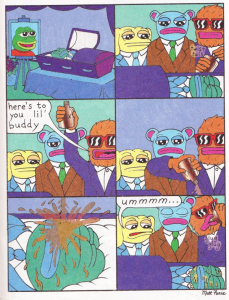
 In a parallel universe, while Pepe was taking on an outsized role in the tapestry of American politics and internet culture, early advances in blockchain technology were starting to take shape. One motif in ‘Pepe twenty-teens memery’ was the concept of rareness. It was an in-joke where Pepe memers claimed to have the rarest pepes, replete with admonition that no one should steal their pepe memes. The joke came to a head when memers started selling pepe jpegs on ebay in 2015, although it is a matter of debate whether actual sales occurred. At the time, the ability to ‘right-click save’ prevented digital scarcity, and therefor true ownership of digital goods. Sure, you could be cited as the creator and as creator you obtained copyright over your images, but provable ownership of a digital good was still beyond mainstream reach. That all changed with the blockchain, which made ownership of digital goods, whether coins, tokens, or NFTs provably scarce. In 2014 Kevin McCoy created the first proto-NFT titled “Quantum” on
In a parallel universe, while Pepe was taking on an outsized role in the tapestry of American politics and internet culture, early advances in blockchain technology were starting to take shape. One motif in ‘Pepe twenty-teens memery’ was the concept of rareness. It was an in-joke where Pepe memers claimed to have the rarest pepes, replete with admonition that no one should steal their pepe memes. The joke came to a head when memers started selling pepe jpegs on ebay in 2015, although it is a matter of debate whether actual sales occurred. At the time, the ability to ‘right-click save’ prevented digital scarcity, and therefor true ownership of digital goods. Sure, you could be cited as the creator and as creator you obtained copyright over your images, but provable ownership of a digital good was still beyond mainstream reach. That all changed with the blockchain, which made ownership of digital goods, whether coins, tokens, or NFTs provably scarce. In 2014 Kevin McCoy created the first proto-NFT titled “Quantum” on
 Namecoin, the first Bitcoin fork. This accomplishment was a monumental shift in the concept of provable ownership of digital goods, and the first instance of a non-fungible digital “token” was created – although the term NFT was still some years away. The website https://nfttimeline.com/ is an excellent resource for navigating the earliest instances of NFTs and NFT-like digital items. Similarly, the twitter user @wrabbit1111 has put together an excellent infographic describing the pre-Ethereum “digital antiquities” market.
Namecoin, the first Bitcoin fork. This accomplishment was a monumental shift in the concept of provable ownership of digital goods, and the first instance of a non-fungible digital “token” was created – although the term NFT was still some years away. The website https://nfttimeline.com/ is an excellent resource for navigating the earliest instances of NFTs and NFT-like digital items. Similarly, the twitter user @wrabbit1111 has put together an excellent infographic describing the pre-Ethereum “digital antiquities” market.


One of the first platforms that enabled the creation of non-fungible tokens was Counterparty. It was developed in 2014 by using a ‘proof-of-burn’ mechanism whereby 2,140 Bitcoin – approximately $1.8M in USD at the time – were burned in order to issue XCP, Counterparty’s native token. The first large scale project to issue NFTs on the Counterparty platform was Spells of Genesis, the first blockchain based mobile game ever made, pioneered by the visionary Shaban Shaame (@shaban_shaame).
Rarepepe Makes its Mark on the Blockchain
The second large scale NFT project to emerge on Counterparty is the subject of this article: Rarepepe. The ability to create truly rare Pepes with provable digital scarcity and ownership took the rare pepe joke and turned it on its head. 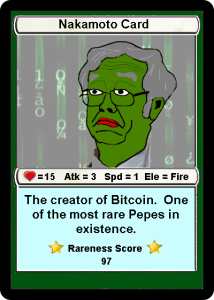
 Pepe memes could now be created in a way that made their ownership and provenance provable and scarce, and therefor bought and sold in markets. Following the Spells of Genesis lead, a group of cypherpunks and early bitcoin adopters created a platform for the minting and sale of truly rare pepes. In 2016, Joe Looney (@wasthatawolf) forked Freewallet’s code to create a rarepepe wallet (rarepepewallet.com), a marketplace for buying and selling these digital artifacts. It was one of the first platforms that enabled people to transact digital artworks. The first rarepepe card titled ‘rarepepe’ was designed and issued by “Mike” (@rarepepe) on September 9th, 2016, and is now referred to as ‘the Nakamoto Card.’ It is widely regarded as an NFT grail by collectors for its historical significance and regularly sells for for hundreds of thousands of dollars, notwithstanding there being 299 in existence. It features a hand drawn portrait of Dorian Nakamoto – one of the first people publicly hypothesized to be Satoshi Nakomoto, although who is decidedly not the founder of Bitcoin – with classic green Pepe skin tone and bright red lips.
Pepe memes could now be created in a way that made their ownership and provenance provable and scarce, and therefor bought and sold in markets. Following the Spells of Genesis lead, a group of cypherpunks and early bitcoin adopters created a platform for the minting and sale of truly rare pepes. In 2016, Joe Looney (@wasthatawolf) forked Freewallet’s code to create a rarepepe wallet (rarepepewallet.com), a marketplace for buying and selling these digital artifacts. It was one of the first platforms that enabled people to transact digital artworks. The first rarepepe card titled ‘rarepepe’ was designed and issued by “Mike” (@rarepepe) on September 9th, 2016, and is now referred to as ‘the Nakamoto Card.’ It is widely regarded as an NFT grail by collectors for its historical significance and regularly sells for for hundreds of thousands of dollars, notwithstanding there being 299 in existence. It features a hand drawn portrait of Dorian Nakamoto – one of the first people publicly hypothesized to be Satoshi Nakomoto, although who is decidedly not the founder of Bitcoin – with classic green Pepe skin tone and bright red lips.
Since issuance of the Nakamoto Card, 1773 additional cards were created by the rarepepe community. The process was simple: members of the original telegram group would submit proposed rarepepes, while a cadre of rarepepe “scientists” would approve or reject the submissions. There were some basic restrictions such as keeping the work SFW, locking the issuance supply, and they had to have a 400×560 aspect ratio. The community art project caught on, receiving submissions from artists all over the world. It was a thing. In the end, 36 series were created containing 1774 cards. All series contained 50 cards with the exception of series 36, the last series, which contains only 24 cards. Each of the 1774 unique cards have a unique number of issuances, ranging from 1 (of which only 7 cards were created with 1 issuance) to 1 Trillion, a distinction held by the PEPEREPUBLIC card. Needless to say, there is a lot of information to digest and understanding the market requires a good deal of fortitude and commitment, as well as familiarity with some special websites and tools (which will be explained in another article). The artwork ranges from professional to decidedly amateur. The subject matter spans the spectrum, but is a unique snapshot of memeable subject matter and ideology specific to cypherpunk aesthetics from 2016 -2018. There are a number of rarepepe artists who were particularly prolific during the minting days, many of whom are currently influential crypto artists and continue to shape the crypto art space generally. https://pepe.wtf is an excellent tool to explore the work of these early pioneers and learn about the history of the project. After completion of the final card, activity in the rarepepespace died down for 2-3 years, with little activity occurring and the community moving onto other things during the bear market.
The Resurgence of Rarepepe
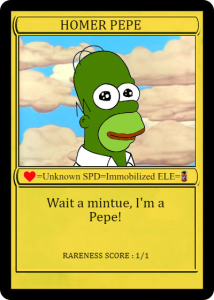
 The rarepepe hibernation ended in 2021, which was a break out year for NFTs. While most of the grift and glam was occurring on the Ethereum blockchain with so called 10k PFP projects such as Bored Ape Yacht Club, renewed interest in rarepepe quietly took hold and galvanized the community and a new slate of collectors. In February of 2021, a famous NFT collector pseudonymously named Mr703 – so called because he minted over 700 cryptopunks – poured much of his cryptopunk earnings into sweeping available cards that remained on rarepepewallet, as well as buying whole wallets from collectors for pennies on the dollar. In March, a 1 of 1 rarepepe called Homerpepe sold at auction for $320,000 to a now famous collector named TokenAngels (@TokenAngels). July is when things really began to snowball, and a goldrush ensued where OG rarepepe collectors and new collectors began scouring rarepepewallet for good deals. This pushed the price of XCP – Counterparty’s native token – from $1.42 up to a local high of $27.38 by mid-September. XCP currently trades at $2.91.
The rarepepe hibernation ended in 2021, which was a break out year for NFTs. While most of the grift and glam was occurring on the Ethereum blockchain with so called 10k PFP projects such as Bored Ape Yacht Club, renewed interest in rarepepe quietly took hold and galvanized the community and a new slate of collectors. In February of 2021, a famous NFT collector pseudonymously named Mr703 – so called because he minted over 700 cryptopunks – poured much of his cryptopunk earnings into sweeping available cards that remained on rarepepewallet, as well as buying whole wallets from collectors for pennies on the dollar. In March, a 1 of 1 rarepepe called Homerpepe sold at auction for $320,000 to a now famous collector named TokenAngels (@TokenAngels). July is when things really began to snowball, and a goldrush ensued where OG rarepepe collectors and new collectors began scouring rarepepewallet for good deals. This pushed the price of XCP – Counterparty’s native token – from $1.42 up to a local high of $27.38 by mid-September. XCP currently trades at $2.91.
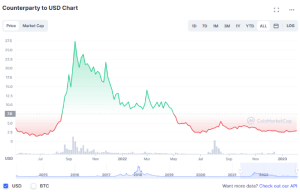

2021 saw a number of additional important events for the rarepepe space. One card “FEELSGOODMAN” (series 20 card 50) was famously reserved for Matt Furie. Having demurred for several years, in September he finally completed the artwork. This was a major moment for the community, and somewhat scandalous. Furie had previously tried to enforce copyrights to his pepe creation, which alienated some rarepepe community members who reject copyright law generally as part of their crypto and artistic ethos. Although some controversy lingers around this piece, it was a moment of celebration and the rarepepe cannon was finally complete. In October, the documentary “Feels Good Man” directed by Arthur Jones (@arthurjones) won a Best News and Documentary Emmy. A protocol called Emblem Vault figured out how to wrap rarepepes and other Counterparty assets in a wrapper that made them compatible with Ethereum, and therefore tradeable on marketplaces like OpenSea. Later that month, a one-of-one Rare Pepe called PEPENOPOULOS sold at Sotheby’s for $3.6 million. Having broken into the tradart world, rarepepe was officially a real and important set of collector’s items. Since then, the bull market has subsided, but interest in rarepepe continues to grow. Values have held up remarkably well, and new collectors are entering the market, despite the technical hurdles required to navigate the marketplace.
Perhaps the most interesting wrinkle in rarepepe is what is occurring now. Since rarepepe’s resurgence, OG and new community members alike have begun starting derivative projects that pay homage to the original. They are all community lead, with curatorial boards vetting art submitted by community members, minted on and sold through bitcoin using Counterparty. 2022 saw a proliferation of art in this space, and has attracted the contributions of some famous and up and coming cypto artists. NFT art on Bitcoin is thus alive and well, continuing to innovate and bring its own aesthetic and values to the blockchain. These projects will be more thoroughly covered in future articles.
Feel free to follow me on Twitter @DanceTurn for regular updates, insights, and market analysis in the rarepepe space.
Disclosure, I have been collecting rarepepes since 2021.
Want more? Connect with NFT Plazas
Join the Weekly Newsletter
Join our Discord
Follow us on Twitter
Like us on Facebook
Follow us on Instagram
*All investment/financial opinions expressed by NFT Plazas are from the personal research and experience of our site moderators and are intended as educational material only. Individuals are required to fully research any product prior to making any kind of investment.

Decentralised human, Explorer, Adventurer.
!function(f,b,e,v,n,t,s){if(f.fbq)return;n=f.fbq=function(){n.callMethod?n.callMethod.apply(n,arguments):n.queue.push(arguments)};if(!f._fbq)f._fbq=n;n.push=n;n.loaded=!0;n.version=’2.0′;n.queue=[];t=b.createElement(e);t.async=!0;t.src=v;s=b.getElementsByTagName(e)[0];s.parentNode.insertBefore(t,s)}(window,document,’script’,’https://connect.facebook.net/en_US/fbevents.js’);




